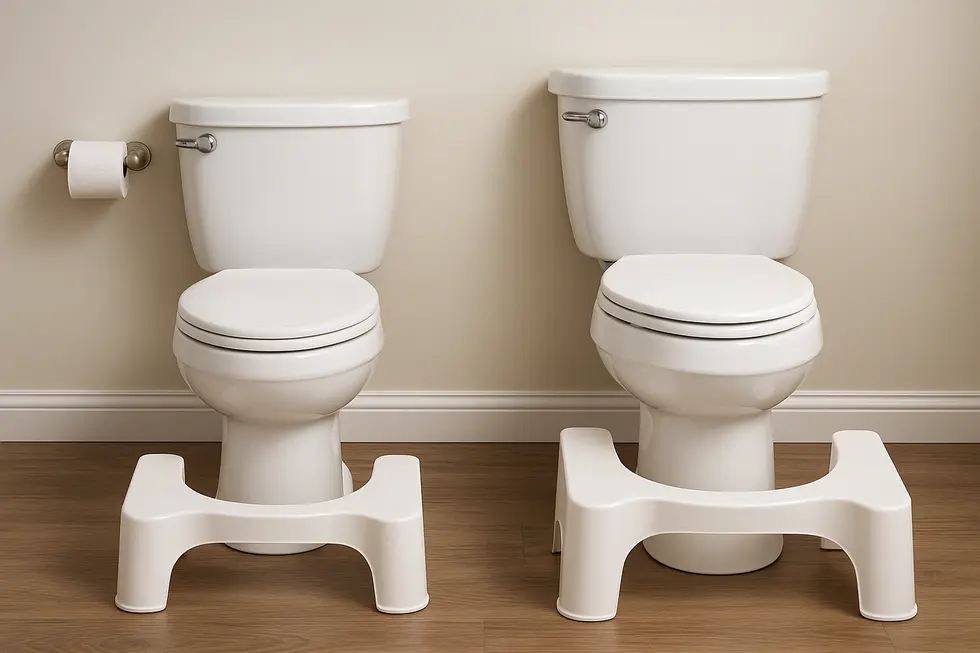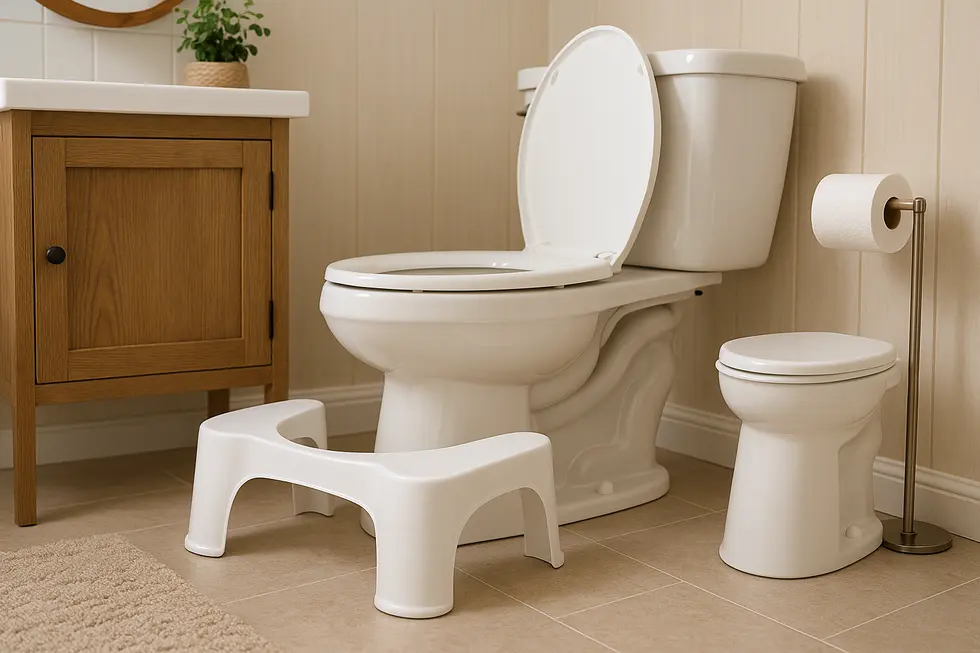Toilet Stools
Finding the Perfect Toilet Stool Height: Comfort & Health in Every Visit
Selecting the right toilet stool height can significantly enhance comfort and support a healthy posture, aiding in better bowel movements. The stool you choose connects directly to the type of toilet, your specific needs, and its design. Understanding how standard and chair-height toilets impact stool height can help you make informed decisions. We’ll explore considerations for choosing the best height and delve into materials and designs that adapt to your needs.
Navigating Toilet Types: Choosing the Ideal Stool Height for Comfort and Health

Finding the appropriate stool height for your toilet can make all the difference in comfort and digestive health. Understanding the two primary types of toilets—standard-height and chair-height—is the first step in optimizing your bathroom setup.
Standard-height toilets, with seats approximately 15 to 16 inches from the floor, are traditionally designed and widely used. They are suitable for most adults and children, providing a conventional and familiar experience. These toilets pair perfectly with toilet stools around 7 inches high. A stool of this height elevates the user’s feet to help mimic a natural squatting position, promoting better colon alignment and, consequently, easier bowel movements.
On the other hand, chair-height toilets, also known as comfort height toilets, feature a seat level that is approximately 17 to 19 inches high. This design is particularly advantageous for older adults or individuals with mobility challenges, as the higher position eases the process of sitting down and getting up. For those using these toilets, taller stools—about 9 inches high—are often preferable. This height adjustment ensures that even with the elevated seat, the knees can still be positioned above the hips, maintaining the beneficial squat-like posture.
When deciding on the ideal toilet stool height, consider the height of your toilet’s seat. If you’re new to using toilet stools, starting with a commonly recommended 7-inch model can be beneficial. Not only does it suit many standard-height toilets, but it also offers a simple introduction to ergonomic alterations of bathroom posture. However, for those who are more flexible or use chair-height toilets, trying a taller, 9-inch stool could enhance your experience by further improving the squatting effect, which is crucial for digestive health.
Before purchasing a toilet stool, it’s wise to test various heights to determine what feels most comfortable and effective for your needs. Measuring your current toilet setup and factoring in your personal preferences and bathroom space constraints will ensure the best purchase decision. Ultimately, choosing the right toilet stool height supports optimal posture, improving not just comfort but also contributing to better health outcomes.
For further insights on selecting the right stool height and understanding the benefits, visit the best toilet stool height guide.
Tailoring Toilet Stool Height for Optimal Comfort and Accessibility

Selecting the right toilet stool height involves various considerations, primarily hinging on the height of the toilet itself. Standard height toilets, with bowl elevations between 14 to 15 inches, are typically paired with stools that raise the feet by 7 to 9 inches. This adjustment helps mimic a squatting posture—deemed crucial for effective bowel movements—by positioning the knees above the hips. In contrast, chair-height toilets, offering bowl heights from 17 to 19 inches, benefit from stools that elevate feet by just 5 to 7 inches, ensuring comfort and maintaining the desired posture.
The ergonomic balancing act doesn’t stop at toilet measurements. Personal comfort becomes a significant influencer, guiding stool height choice. A well-selected stool should facilitate a natural alignment that supports digestive health by minimizing the strain during bowel movements. Individuals with specific mobility issues, such as back pain or reduced flexibility, may find that a higher stool eases tension by reducing the degree of bending required. This position promotes not only comfort but also long-term health benefits.
When accessibility is paramount, especially for the elderly or disabled, chair-height toilets paired with appropriate stool heights can make a world of difference. These ADA-compliant toilets make sitting and standing easier and safer, particularly when complemented by grab bars and other bathroom safety features. Toilet stool selection should always consider and harmonize with these accessibility improvements, ensuring every aspect of the bathroom experience encourages independence and security.
For those seeking a deeper insight into the significance of selecting the correct toilet stool height, consider diving into resources that explore these toilet stool ergonomic principles. They detail how minor adjustments can lead to marked improvements in comfort and digestive health. While the primary aim is enhanced bowel function, these stools contribute significantly to an inclusive and comfortable bathroom environment for varying physical needs.
Crafting an Optimal Toilet Stool: The Role of Material and Design

Choosing the right height for a toilet stool is just the beginning of ensuring a comfortable and health-promoting bathroom experience. Equally critical are the material and design elements of these stools, which not only contribute to functionality but also enhance user comfort and integrate seamlessly into modern bathroom aesthetics.
When considering materials, durability and ease of cleaning are key priorities. Many toilet stools are crafted from smooth plastics or other hygienic materials that resist moisture and bacteria, simplifying maintenance and ensuring longevity. For individuals concerned about appearance, some designs incorporate integrated lids or finishes that mimic traditional bathroom fixtures. These elements help the stool blend into the bathroom environment without drawing unnecessary attention to its presence.
In terms of design, personal comfort and hygiene are paramount. Contoured shapes are popular as they provide ergonomic support and help maintain a comfortable posture. Some stools feature sloped fronts that afford easier access to personal hygiene, a consideration vital for those with limited mobility. This ergonomic focus is not purely for comfort but also enhances bathroom safety by minimizing the movement needed to reach and cleanse effectively.
Customization is another feature that can’t be overlooked. Models like the Homecraft Savanah Raised Toilet Seat offer multiple height settings, providing adaptability for various user needs and preferences. This flexibility is particularly beneficial for households where more than one person will use the toilet stool, or for individuals whose needs may change over time due to health considerations. The ability to adjust height is crucial for avoiding strain and reducing the risk of falls, especially among the elderly or those with conditions that affect mobility or balance.
Beyond the stool, bathroom safety is a holistic concern. Consistency across fixtures, such as ensuring shower seats are at an appropriate height, further promotes stability. Proper installation of these bathroom aids not only enhances user safety but also boosts independence, making everyday rituals a bit more manageable and dignified.
For more information on customizing your bathroom for safety and comfort, explore these helpful guides: Visit for more.
Final thoughts
Choosing the best toilet stool height involves understanding the nuances of toilet types, user preferences, and design materials. By matching stool height to the toilet and personal needs, you can enhance comfort and promote a healthy posture. This targeted choice contributes to improved daily routines and well-being, proving that even small adjustments in bathroom accessories can have a significant impact.
Experience a new standard of clean with PEGABidet—designed for comfort, safety, and independence. Join thousands who trust us to make personal care simple and dignified. Contact us at contact@pegabidet.com
About us
PEGABidet is a brand owned by L.A NEXTGEN LLC, based in California. We design intuitive, hygienic, and accessible bathroom solutions that prioritize safety, dignity, and independence. Our mission is to make personal care effortless and empowering for people at every stage of life.

